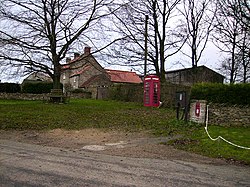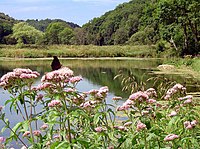Scawton
| Scawton | |
| Yorkshire North Riding | |
|---|---|
 Scawton | |
| Location | |
| Grid reference: | SE548835 |
| Location: | 54°14’38"N, 1°9’32"W |
| Data | |
| Post town: | Thirsk |
| Postcode: | YO7 |
| Dialling code: | 01439 |
| Local Government | |
| Council: | North Yorkshire |
| Parliamentary constituency: |
Thirsk and Malton |
Scawton is a village in Ryedale, in the North Riding of Yorkshire. The hamlet lies just east of Sutton Bank, north of the A170 road, and five miles west of Helmsley,[1] in the Hambleton Hills.
The wider parish was the setting, in 1322, for the Battle of Old Byland, on Scawton Moor to the south, at which Robert the Bruce defeated the Earl of Richmond.
The road through the village used to link the two abbeys at Byland and Rievaulx, with the church, and possibly the village pub, being instigated by the monks for the use of travellers.
History
Scawton is listed in the Domesday Book as belonging to Count Robert of Mortain.[2] The name is recorded as Scaltun in the Domesday Book, and has been written in documents as Scalton, Scaltona, Skalton and Scaulton, with Scawton first recorded in 1536. The name means farm in the hollow, where the word Skál means hollow.[3][4] The soil was described as being poor, and sits on top of Kimmeridge clay.[5] Further down, the land sits atop Hambleton Oolite, a white to grey fine ooidal limestone that was used for building houses and drystone walls in the area.[6] Several old quarries dot the landscape in and around Scawton.[7] Some of the purer limestone quarried on Scawton Moor was burnt to provide lime and mortar.[8][9]
One former occupation of the villagers was operating bleachfields (open land for purify and whitening cloth by the action of sunlight) for a beetling mill in Crathorne. Bleachfields were common in the western Hambleton Hills in the late 18th century, with records of this activity being at Wass, Byland and Oldstead besides Scawton. The farm fields were used to dry out the cloth.[10]
Parish church
The parish church, St Mary, is of the 12th century. The church was built by the monks who later inhabited Byland Abbey. It was renovated in 1892 by C. Hodgson Fowler.[11]
The church is now a Grade I listed building.[12]
About the village
Scawton has a pub, The Hare,[13] and
South of the village is a sawmill and woodworkers who use oak.[14] There are no shopping amenities, and the hamlet has only a small number of properties, with some outlying farmsteads in the surrounding area.[15] One of the few non-stone construction buildings in the hamlet is the village hall/reading room; this is made from corrugated green iron.[16][17]
The road through the hamlet, known as Sperragate, links the A170 with the village of Old Byland and Rievaulx. This used to be the main route between Helmsley and Hambleton, before carrying on to Thirsk. The route is marked in Scawton with a wayside cross.[18] The route was used by, and possible built for, the monks who used it to travel between the abbeys of Rievaulx and Byland. Besides building the church, the monks are thought to have built the pub for the use of travellers.[19]
To the north of the village are several small valleys, including Flassen Dale and Nettle Dale, all of which feed water into the River Rye at Rievaulx.[20] Nettle Dale has several large ponds in the narrow valley which are believed to have been created as fishponds by the monks of Rievaulx.
A long-distance footpath, the Cleveland Way, runs through Nettle Dale from Helmsley towards Cold Kirby and Sutton Bank.[21]
Scawton Moor
Within the parish, and south of the hamlet, lies Scawton Moor. An Iron Age burial mound was excavated here in the 1950s.[22]
On Scawton Moor was fought the Battle of Old Byland in 1322. That year, King Edward II had made a humiliating withdrawal from Scotland, and was faced with an immediate rebellion from his barons. Robert the Bruce took the opportuntiy to pursue Edward into England, and on Scawton Moor he routed the English under the Earl of Richmond. King Edward II had been emvamped nearby at Rievaulx and was forced to flee.[23]
In the 1960s, over 150 acres of Scawton Moor were planted with conifer trees by the Forestry Commission.[24]
Outside links
References
- ↑ Information on Scawton from GENUKI
- ↑ Scawton in the Domesday Book
- ↑ Ekwall, Eilert, The Concise Oxford Dictionary of English Place-Names. Oxford, Oxford University Press, 4th edition, 1960. p. 407 ISBN 0198691033
- ↑ "Scawton :: Survey of English Place-Names". http://epns.nottingham.ac.uk/browse/North+Riding+of+Yorkshire/Scawton/53286b32b47fc40bc6000596-Scawton.
- ↑ A History of the County of York: North Riding - Volume 1 pp 555-557: Parishes: Scawton (Victoria County History)
- ↑ "Strategic Stone Study A Building Stone Atlas of North Yorkshire East and York" (PDF). Historic England. December 2017. p. 12. https://www2.bgs.ac.uk/mineralsuk/download/EHCountyAtlases/North_Yorkshire_East_York_Building_Stone_Atlas.pdf.
- ↑ "Scawton and Scawton Moor". https://maps.nls.uk/geo/explore/#zoom=16&lat=54.24489&lon=-1.15625&layers=168&b=1.
- ↑ Powell, J H; Ford, J R (2011). "Lime and Ice Project: an overview of the geology and geomorphology of part of the Hambleton and Howardian hills for the North York Moors National Park Authority" (PDF). p. 15. http://nora.nerc.ac.uk/id/eprint/519267/1/CR11099N.pdf.
- ↑ "Scattergate - Scoulton | British History Online". https://www.british-history.ac.uk/topographical-dict/england/pp30-34#h3-0004.
- ↑ Hastings, R. P. (1981). Essays in North Riding history, 1780-1850. Northallerton, North Yorkshire: North Yorkshire County Council. p. 34. ISBN 0906035171.
- ↑ "St Mary, Scawton". http://www.upperryedale.org.uk/scawton.htm.
- ↑ National Heritage List 1149196: Church of Saint Mary (Grade I listing)
- ↑ Urwin, Simon (22 January 2021). "The Hare". The Telegraph. https://www.telegraph.co.uk/travel/destinations/europe/united-kingdom/england/yorkshire/north/hotels/the-hare-inn-hotel/.
- ↑ Langholz, Samina (2018). Woodworking : traditional craft for modern living. London: Jacqui Small. p. 142. ISBN 9781911127376.
- ↑ "Lime and ice; landscape character assessment" (PDF). p. 50. https://www.northyorkmoors.org.uk/looking-after/our-projects-and-partnerships/previous-projects/lime-and-ice/landscape-character/LCA-Compressed-FINAL-compressed.pdf.
- ↑ "Hare do". The Northern Echo. 12 August 2008. https://www.thenorthernecho.co.uk/opinion/latest/3587954.hare/.
- ↑ Wilkinson, George (2 August 2000). "Cold front". York Press. https://www.yorkpress.co.uk/news/7954218.cold-front/.
- ↑ National Heritage List 1012889: Wayside cross base on south side of the churchyard wall at Scawton (Scheduled ancient monument entry)
- ↑ Frank, George (1888). Ryedale and North Yorkshire antiquities. London: E Stock. p. 116. OCLC 4986493.
- ↑ Reid, Mark (20 June 2019). "Scawton, Flassen Dale & Cold Kirby" (PDF). https://www.thenorthernecho.co.uk/resources/files/32290.
- ↑ Boyes, Malcolm (1977). A guide to the Cleveland Way and Missing Link. London: Constable. p. 25. ISBN 0094613907.
- ↑ National Heritage List 1019337: Square barrow on Scawton Moor, adjacent to the quarry between Snip Gill Slack and Sword Rigg Slack (Scheduled ancient monument entry)
- ↑ Winn, Christopher (2010). I never knew that about Yorkshire. London: Ebury. p. 109. ISBN 978-0-09-193313-5.
- ↑ "Deer Park Forest Plan". https://www.forestryengland.uk/forest-planning/deer-park-forest-plan.
